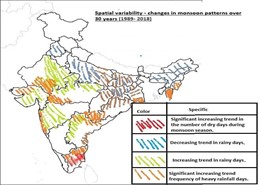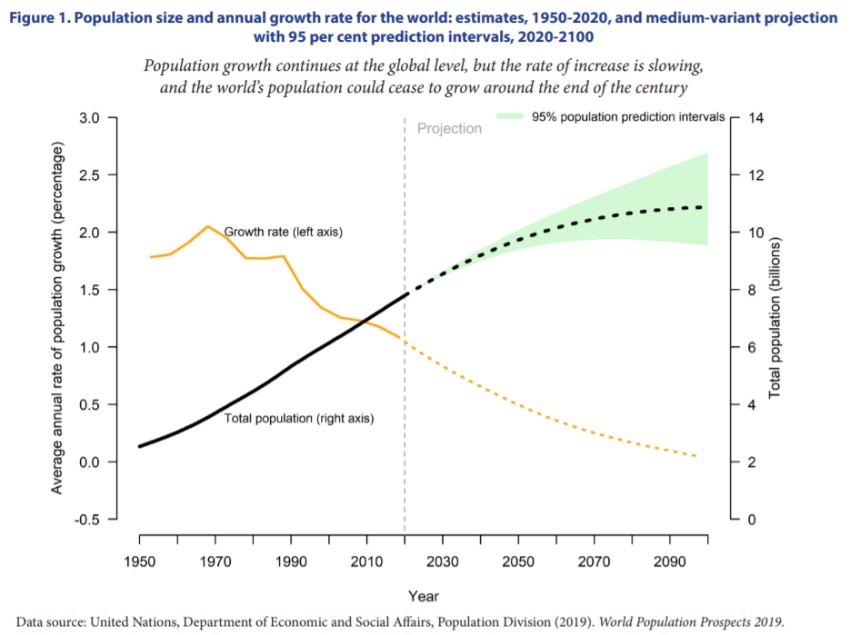31 Jul
Marine plastic pollution & impacts on marine biodiversity
In News
A new study published in Global Environmental Change found that Impacts of marine plastic pollution now rank among the top of marine-related threats.
Introduction
Plastic pollution is recognized as a severe anthropogenic issue in the coastal and marine ecosystems across the world. A staggering 8 million tonnes of plastic end up in the world’s oceans every year. Further, Covid-19 has led to a pandemic of plastic pollution due to increased use of items such as disposable masks. Plastic pollutants are distributed in the ecosystems in different forms, with different size variations as megaplastic, macroplastic, mesoplastic, and microplastic. Microplastics in primary and secondary forms reveal a widespread distribution in the water, sediment, and biota of the marine and coastal habitats. If current trends continue, our oceans could contain more plastic than fish by 2050. Accordingly, plastic pollution creates several kinds of negative consequences combined with ecological and socio-economic effects.
Global distribution of Marine Plastic Pollution (MPP) and MPP in the marine environment
- Beaches: Anthropogenic litter, primarily plastic and polystyrene, directly and regularly affects coastal environments due to their proximity to major sources. Beaches are hotspots for MPP. E.g., a 2018 study found the accumulation of marine litter a prevalent problem throughout the Chilean region, with higher MPP densities in heavily populated areas.
- Open Ocean: The buoyancy of most plastic materials in seawater means concentrations are highest in surface waters. Floating plastic items are easily transported by ocean currents. Occasionally, these currents pull plastic items away from coastlines into the open ocean where they can accumulate in high densities. Observational studies in pelagic zones demonstrate MPP extends across all latitudes, including polar seas. Analogous to a conveyer belt, the large-scale vortices of the ocean’s subtropical gyres act as accumulation zones for MPP.
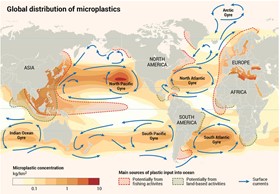

- Benthic and sediment plastics: Plastic items that are denser than seawater typically sink near their original input source, e.g., coastlines and dumping sites, but can still be transported by subsurface currents. Furthermore, the density of plastic can increase through degradation and fragmentation, allowing originally larger, buoyant materials to sink.
- MPP recovered from biota: Anthropogenic litter, specifically plastic, is perceived as one of the greatest ecological threats to humans and marine ecosystems. A growing number of studies are documenting species’ ingestion of Microplastics, especially by invertebrates and fish species.
Sources of plastics into Ocean
- Land-based: Two sources perpetuate the land-to-sea exchange of plastics: direct littering and dumping of plastics into the ocean due to tourism etc; and the loss of plastics from open dumps and landfills that make their way seaward.
- The rapid urbanisation of coastlines presents a significant challenge, seeing as most MPP is thought to be deposited locally. For example, 160 million residents now occupy roughly 46,000km of coastline along the Mediterranean Sea, and this coastal population boom is considered the primary cause of the region’s high marine litter concentration.
- Rivers carry plastic waste from deep inland to the sea, making them major contributors to ocean pollution. Annually, river systems transport 1.15 - 2.41 million tonnes of plastic litter to the oceans.
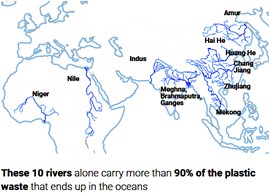
- Ocean-based debris: Marine activities make a great contribution to MPP. For example, fisheries are the largest ocean-based contributor of MPP, depositing over 65,000 tonnes of plastic a year, which amounts to roughly 10% of all marine litter. Fishing vessels in waters throughout the world contribute considerably to MPP, from the Western and Central Pacific, to all along the Atlantic Coast of North America. In addition to fisheries, maritime shipping, navigation actions, waste disposal, and fish culture are also significant inputs of ocean-based plastic litter.

Impact of Plastics on the Marine Environment
- Entanglement and ingestion of plastics: These are the two main causes of mortality in marine organisms. Entangled marine life is a global issue that affects a number of groups of marine organisms, including 100% of sea turtle species, 67% of seal species, 31% of cetacean species, and 36% of seabird species. Marine mammals, turtles, and plunge-diving bird species suffer most from entanglement; they get stuck in nets, six-pack rings, or fishing lines and die from starvation, suffocation, or strangulation.
- Chemical Impact and Ecotoxicology
- Plastic debris in ocean can leach chemical contaminants such as phthalates, bisphenol A, and brominated flame retardants (BFRs) into waters that are absorbed by marine species. These chemicals affect development and reproduction of a wide range of species. E.g., alterations in number of offspring produced, reduced hatching success, and disruption of larval development of molluscs, crustaceans, and amphibians.
- Transfer of Contaminants from Plastics to Organisms: Most marine organisms obtain contaminants from plastics by ingesting plastic debris. Toxicants may bioaccumulate and toxicant concentrations may also increase through transfer within a food web (biomagnifications). Thus, higher trophic level organisms are exposed to enriched concentrations of contaminants via their prey.
- Dispersal via rafting, including transport of invasive species: Floating debris such as microplastic may provide a habitat for microorganisms, thus increasing the potential for transport of organisms on marine debris. Organisms like algae, mussels, covered with marine organisms have been found floating in the Pacific Ocean and often wash ashore. In a study on hitch-hiking of organisms on floating debris, it was reported that an exotic barnacle had attached itself to plastic debris found near the Shetland Islands (Northern Atlantic). The incidence of anthropogenic debris more than doubled the rafting opportunities for organisms and is a serious threat to global biodiversity.
- Ecosystem level effects: There is a significant negative relationship between the level of marine plastic debris cover and coral cover, with coral cover and species diversity decreasing with increasing debris abundance, as observed on Majuro Atoll (Marshall Islands). Ecosystem impacts can also occur in the intertidal. For example, Microplastics and debris fragments on beaches have been reported to alter the porosity of the sediment and its heat transfer capacity. Studies also suggest that increased debris loads could lead to reduced subsurface temperatures, potentially affecting organisms such as sea turtles whose sex-determination relies on temperature.
Socio-economic impacts of MPP:
- The socio-economic impacts of marine debris are extensive and overwhelmingly negative, causing (or contributing to) economic losses to industries such as commercial fishing and shipping, as well as recreation and tourism.
- Furthermore this is a trans-boundary problem, resulting in costs to countries that may be far from the point of origin of the debris.
- In locations such as tropical Small Islands Developing States, it is also detrimental to eco-tourism and sporting activities that rely on the presence of healthy ecosystems. In addition, the presence of marine debris can have negative implications for human health.

Way Forward:
- Legal efforts have been made at the international and national levels to address marine pollution. The most important are the 1972 Convention on the Prevention of Marine Pollution by Dumping Wastes and Other Matter (or the London Convention), the 1996 Protocol to the London Convention (the London Protocol), and the 1978 Protocol to the International Convention for the Prevention of Pollution from Ships (MARPOL). However, compliance with these laws is still poor, partly due to limited financial resources to enforce them. Existing international legally binding instruments should be further explored to address plastic pollution.

- Successful global initiatives: IUCN is running the Marine Plastics and Coastal Communities initiative (MARPLASTICCs) in Africa and Asia that works in five countries: Kenya, Mozambique, South Africa, Thailand, and Viet Nam. IUCN MARPLASTICCs project provides Institutional Frameworks governing MPP to understand marine plastic pollution and Extended Producer Responsibility in Asia and Africa.
- There is a fundamental need to move to circularity and resource efficiency. For this we need to rope in Private players, grassroot community along with better use of science and technology.
The way we currently produce and consume plastics is not sustainable. The massive production and consumption of plastics, especially single use plastic products, have contributed greatly to the plastic pollution crisis. Marine plastic pollution impacts our ecosystems, endangers animal lives and also threatens human health. pollution is a multidimensional problem that requires a holistic approach. Game-changing steps have to be taken by all economic players - producers, policy-makers, businesses and consumers worldwide to successfully achieve the SDG 12 – Responsible consumption and production and SDG 14 – Life below water.
Where can we use it
Paper1: Oceanography (Marine resources, marine pollution), Biogeography, Environmental geo (influence of man on ecology and environment, ecosystem degradation, sustainable development), Economic geo (world resources, LTG).
Paper2: Resources, contemporary issues (issues related to pollution).
GS: P3 (conservation, environmental pollution and degradation)
IMPACT OF CLIMATE CHANGE ON FOOD PRODUCTION
- WHY IN NEWS?
- Recently, the One Earth Report highlighted the challenges of rising carbon emissions. According to the report,"Climate change risks pushing one-third of food production outside safe climatic space”.

Fig :Inter-linkages between the climate system and food production.
- Challenges in food production due to climate change:-Climate change can pose challenges in growth of crops:
- Changes in temperature: If the temperature exceeds optimum temperature, yields of crops will decline.
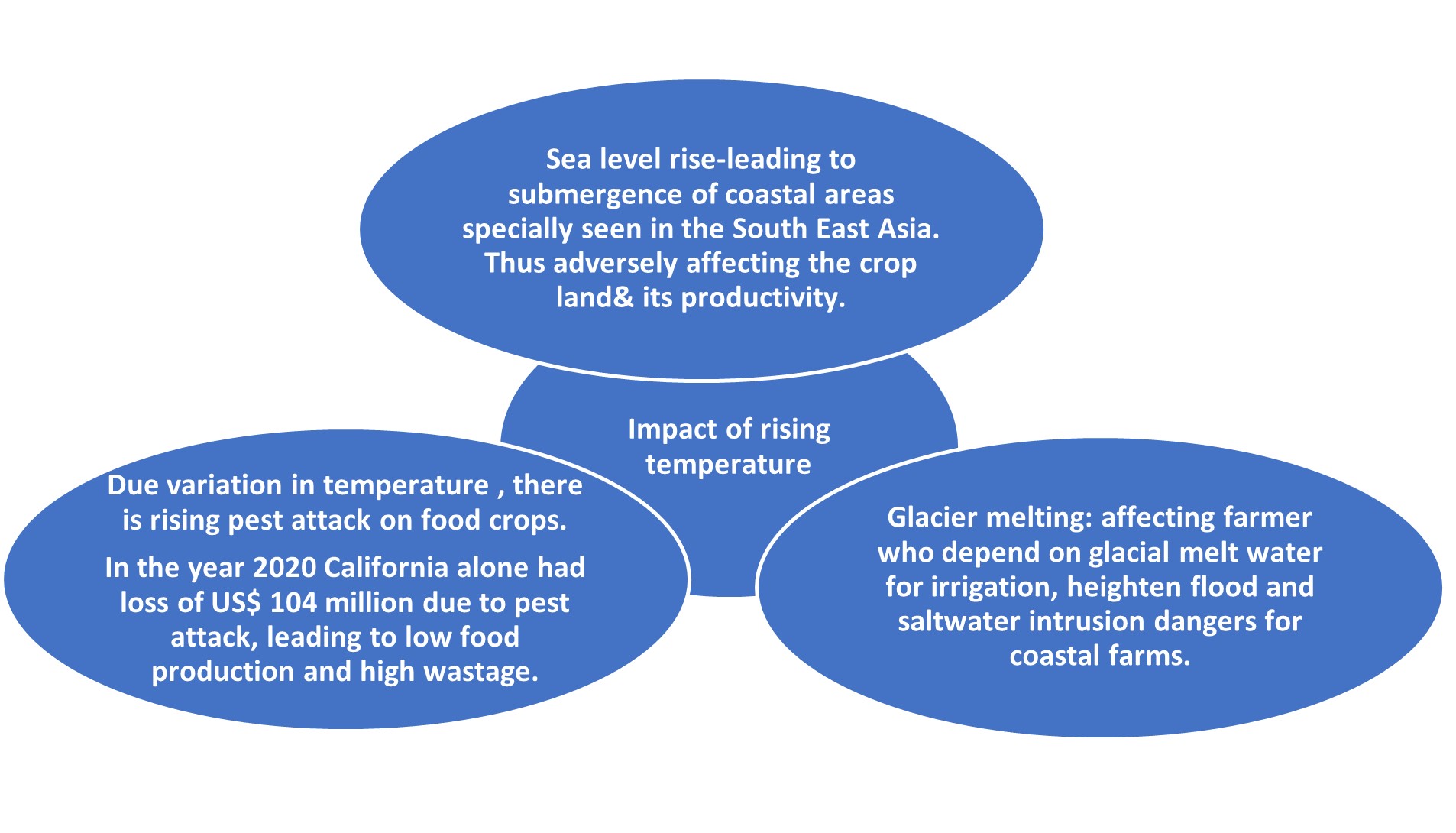
As per report, temperature will rise by 3.7 per cent by the end of this century and Safe Climate Space (SCS) will shrink and at same time the productivity of rice & wheat would be affected.
-
- Elevated CO2 levels can increase plant growth, however, other factors, such as, ozone pollution, and water and nutrient constraints, may counteract these potential increases in yield.
- Variation in rainfall pattern- rapid and unhalted growth of greenhouse gas emissions could affect rainfall patterns, causing floods and droughts, can harm crops and reduce yields.
- Many weeds, pests, and fungi thrive under warmer temperatures, wetter climates, and increased CO2 levels- which compete with crops for light, water, and nutrients, could cause new problems for farmers crops previously unexposed to these species.
- Climate change is also expected to impact ecosystems and the services they provide to agriculture, such as pollination and pest control by natural predators.
- As per the Limits to growth theory rising temperature if unchecked would lead to collapse of agricultural activities- global yields could decline by up to 30 percent by 2050(UN data).
- Impact on productivity of allied activities:
- Livestock productivity:
- Drought may threaten pasture and feed supplies. Drought reduces the amount of quality forage available to grazing livestock.
- Climate change may increase the prevalence of parasites and diseases that affect livestock.
- On horticulture: Declines in yields and crop suitability are projected under higher temperatures, especially in tropical and semi-tropical regions.
- On fisheries:.
- Many aquatic species can find colder areas of streams and lakes or move north along the coast or in the ocean, putting these species into competition with other species over food and other resources
- Livestock productivity:
Example: Higher water temperatures and higher estuarine salinities have enabled an oyster parasite to spread farther north along the Atlantic coast.
-
- Changes in temperature and seasons can affect the timing of reproduction and migration.
For example, in the Northwest warmer water temperatures may affect the lifecycle of salmon and increase the likelihood of disease.
- However, some crops are better able to withstand harsher sunlight than others, so rather than growing sensitive plants, farmers might shift to climate resilient and climate smart crops such as root crops, GM crops etc. Also in higher-latitude regions, yields of some crops (e.g., maize, wheat, and sugar beets) have been affected positively over recent decade.
- Steps taken:
- Climate Smart Agriculture: “FAO initiative of Climatehttps://www.downtoearth.org.in/news/climate-change/climate-change-food-production-in-africa-s-sudano-sahelian-zone-under-threat-finds-study-76957 Smart Agriculture" has led to increase in crop productivity (millets) in the region of Nigeria & Chad.
- Great Green Wall Programme: This program was initiated in China to control climate change led land degradation and to increase food productivity in Gobi desert region. The success of this led to Great Green Wall Program in India and African dry region .
- The scientists have made pest-tolerant, salt-tolerant varieties of seeds, using biotechnology.
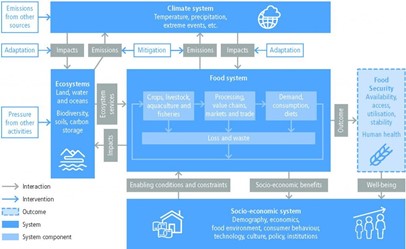
- Where can we use it:
Paper 1: Climatology (climate change) and Economic geography.
Paper 2: Agriculture and contemporary issues.
GS: P1 (Important geophysical phenomena, changes in important geographical features and the effects), P3 (Cropping pattern)
Source
Marine Fisheries in India- An Opportunity Missed
- In news: India recently opposed move by developed countries at the WTO to scrap subsidies for fishermen, demanding a balance between current and future fishing needs of developing countries.
- Background: Presently, India ranks second in the world in total fish production with an annual total production of 13.7 million metric ton in 2018-19 of which 65 per cent was from inland sector and only 35 from marine fisheries. Thus the potential of marine fisheries is yet to be realized in India.
- Challenges in reaping potential:
- Over-exploitation at pace where the fish population cannot replenish itself:
According to Greenpeace report, around 90 per cent of India’s fish resources are at or above maximum sustainable levels of exploitation.
-
- Inadequate infrastructure: especially fishing harbours, landing centers, cold chains and distribution systems, poor processing and value addition, wastage, traceability and certification, non-availability of skilled manpower, etc.
- Geopolitical issues: issues with maritime neighbors prove to be a major hindrance in realizing potential. Example: The on-going disagreement over the territorial rights to the island of Kachchatheevu with Sri Lanka.
- Unsustainable practices: like bottom trawling, cyanide fishing, etc exploit shallow surface resources and hurt long term yield by causing pollution and toxicity.
- Untapped potential of Deep sea fishing: there is an ample scope for increasing production by venturing into deeper waters of the EEZ, which holds a potential of 17 mn tons of unexploited and underexploited fin fishes and shell fishes. (Meena Kumari recommendation were majorily rejected in this regard)
- Climate change: natural and anthropogenic climate change and pollution create frequent occurrence of dead zones leading to change in physical and behavioral characteristics causing loss of fishing zones.
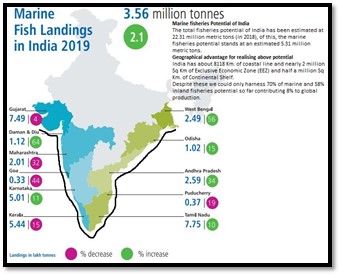
- A sustainable way forward:
- Sustainable alternative livelihood opportunities like mariculture activities.
- The mitigation and control of aquatic diseases.
- The regional geopolitical dimensions also need adequate attention to ensure coordinated and cooperative management of shared fisheries resources and their long-term sustainability.
Case study: Sea Cage farming, Vietnam
The success of the cage farming attributed to the end-to-end supply chain established over the decades and good market and support services. This attracted the big corporate companies to invest due to which Vietnam contributes around 90% of the world pangasius production and helped Vietnam reap its marine fisheries resources.
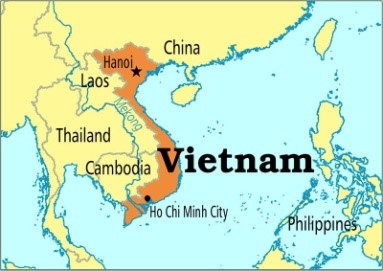
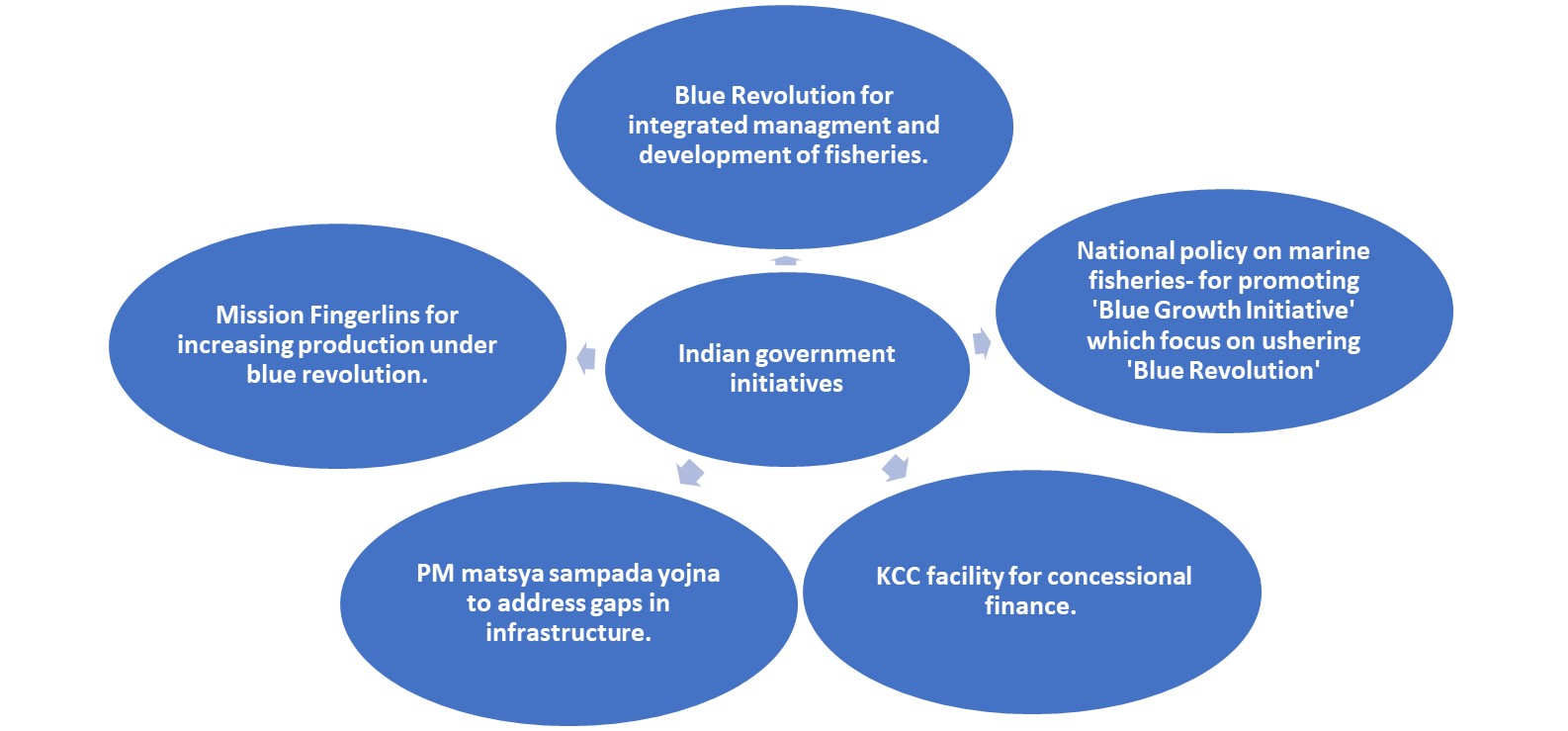
- Draft National fisheries policy 2020 aims to consolidate the sectoral gains and ensure sustainable growth through policy support in order to enable and accelerate marine fisheries development in a responsible and inclusive manner through multi-pronged strategies and focused interventions to provide the requisite impetus for realizing the full potential across the country.
- Where can we use it:
Geography
Paper1: climatology (climate change), oceanography (marine resources), Economic geo (food security).
Paper2: Resources (marine resources), agriculture, contemporary issues.
GS: P1 (world resources, geophysical phenomena- climate change), P3 (agriculture, food security).
Rock fall
- It’s a type of landslide where a fall starts with the detachment of rock from a steep slope along a surface on which little or no shear displacement takes place. The material then descends largely by falling, bouncing or rolling.
- Separation occurs along discontinuities such as fractures, joints, and bedding planes. Falls are strongly influenced by gravity, mechanical weathering, and the presence of interstitial water.
- Causes: Geological causes include weathered, weak and sheared materials, adversely oriented discontinuity, Contrast in permeability of materials. Morphological causes include: Glacial Rebound, Tectonic or volcanic uplift, subterranean erosion, freeze-and-thaw weathering etc. Human causes include: deforestation, mining, irrigation, artificial vibration etc.
- Consequences: It will result in the collection of rock or debris near the base of the slope. It may cause damage to life, vehicles, infrastructure and biodiversity.
- Examples :The recent rock fall in the Kinnaur district of Himachal Pradesh which damaged a bridge on the Baspa River. Another, massive rockfall occurred in April 2017 on the highway NH-44A, near Lengpui Airport, Mizoram
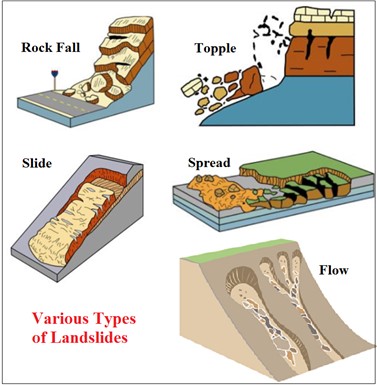
Tombolo
- A Tombolo is a significant depositional feature formed by the sea-waves.
- The ridges, embankments or mounds of sands formed by sedimentation through sea waves parallel to the shoreline are called
- A bar becomes Tombolo, when it connects the mainland with an island or connects a headland with the island.
- Thus, a Tombolo acts as a bridge between the coast and an island.
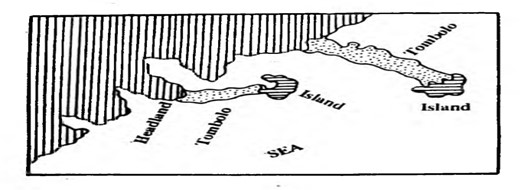
- How is Tombolo formed? Long-shore drift occurs as waves push sediment (which may consist of sand, silt, and clay) towards the coastline at an angle. A true tombolo is formed by processes of wave diffraction and refraction. Due to diffraction & refraction, sediments get arranged across coast and leads to formation tombolo.
- Tombolo in India: A few examples of tombolo are observed along the western coast of India between Ratnagiri and Malvan.
- Sources:- S. Singh Geomorphology Page 457
Satellite Town
- It’s a concept in urban planning that refers to a smaller town in the vicinity of big city, but it’s not the suburban expansion of the main city.
- Features: It must be an independent town with its own history and economy which is different from the main city, own cultural heritage and down town centres, physically distinct from the main city.
- Objectives: Urban decongestion (much along the lines of Stouffer's law of intervening opportunities), economic sub centre, optimum utilization of land, mitigating the urban climate change, converting the labour force into work force.
- Examples: Meerut and Jaipur are satellite towns for Delhi, Pune for Mumbai and Mysore for Bangalore.
- Initiatives: Ministry of Housing and Urban affairs launched its flagship scheme called Urban Infrastructure Development Scheme for Satellite Towns (UIDSST) for developing satellite towns around 7 megacities namely: Pilkhuwa and Sonepat (near Delhi), Sanand (near Ahmedabad), Vasai-Virar (near Mumbai), Vikarabad (near Hyderabad), Sriperumbudur (near Chennai), and Hosakote (near Bengaluru) focussing on the development of 3 sectors of essential infrastructure facilities like water supply, sewerage/drainage, solid waste management.
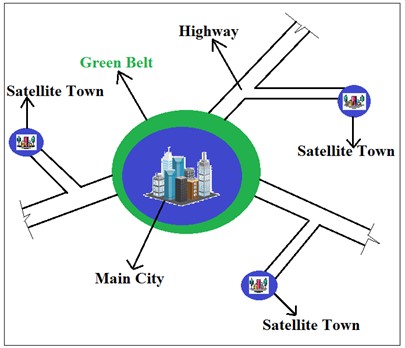
Watershed Development: Thathar Village
Background: Thathar village is situated at the foothills of Shivalik Hills in the Panchkula district of Haryana. It is a part of the Dangri watershed (Dangri River is a tributary of the Ghaggar River). The village was suffering from severe water scarcity, unemployment, lack of health facilities, reducing green cover and increasing soil erosion. Shortages of water and fodder meant that during the dry season the men had to graze their cattle in faraway areas.

Plan of Action:
Integrated Watershed Development Project (IWDP) was launched in Thathar village April 1999, which was funded by the World Bank. By the end of 2005, the socio-economic status of the village has drastically improved. Under this project, several measures were taken such as the following:
- Developmental experts carried out a Participatory Rural Appraisal of the village along with Resource Mapping.
Result: This helped experts and villagers in identifying the main problems of the village.
- Then, a Village Development Committee was formed to figure out solutions to the above identified problems.
- Then several developmental activities have been carried under IWDP by incorporating the knowledge and opinions of the rural people such as identifying water sources, building surface dams, developing irrigation systems, planting trees and installing structures to prevent soil erosion, promoting horticulture to supplement farmers income etc.
Outcomes:

Where this Case Study can be used?
This case study can be used in topics related to GS1 (Integrated water resources management, GS3 (Rural development), Paper 1 (Soil erosion, Environmental issues in Rural settlements, Planning for sustainable development), Paper 2 (Integrated rural area development, Watershed Development, Decentralized planning, Sustainable development).
Places in news - Dholavira
|
Dholavira:
|
|
Vashishti river:
|
|
Thanjavur:
|
|
Ramgarh Vishdhari Tiger reserve:
|
|
Kishanganj:
|
|
Chilika lake:
|
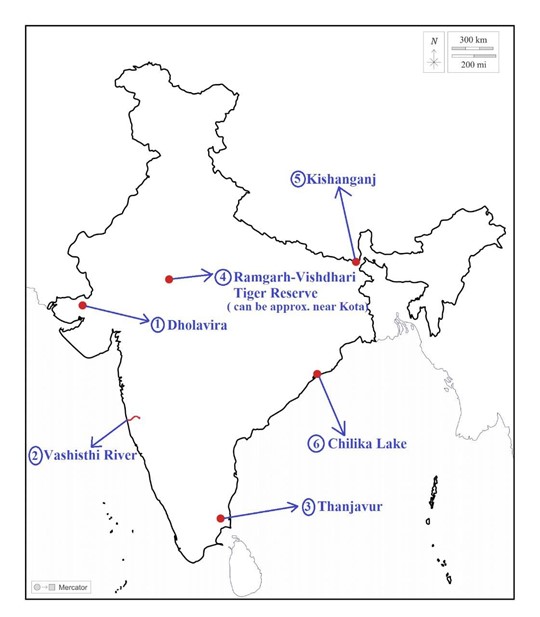
Share the article
Get Latest Updates on Offers, Event dates, and free Mentorship sessions.

Get in touch with our Expert Academic Counsellors 👋
FAQs
Geography Current Affairs focuses on the contemporary issues, events, and developments in the field of geography. It covers recent geographical phenomena, environmental changes, geopolitical shifts, and related news. This differs from regular geography studies which may focus more on foundational concepts, historical contexts, and theoretical frameworks.
Updates are provided regularly to ensure that subscribers stay informed about the latest developments in geography. Typically, updates are provided on a fortnightly basis, depending on the frequency of significant events and changes in the field.
Absolutely. Geography Current Affairs serves as a valuable resource not only for Geography optional but also for GS papers, especially GS Paper 1 (covering Indian Heritage and Culture, History, and Geography of the World and Society) and GS Paper 3 (covering Technology, Economic Development, Biodiversity, Environment, Security, and Disaster Management). It aids in building a holistic understanding of various topics and strengthens answer-writing skills by incorporating contemporary examples and perspectives.
Geography Current Affairs holds immense importance for UPSC preparation, particularly for aspirants opting for Geography optional. It helps candidates stay updated with the latest developments, geographical phenomena, environmental issues, and geopolitical shifts worldwide, aligning them with the dynamic nature of the subject as tested in the UPSC examinations.


